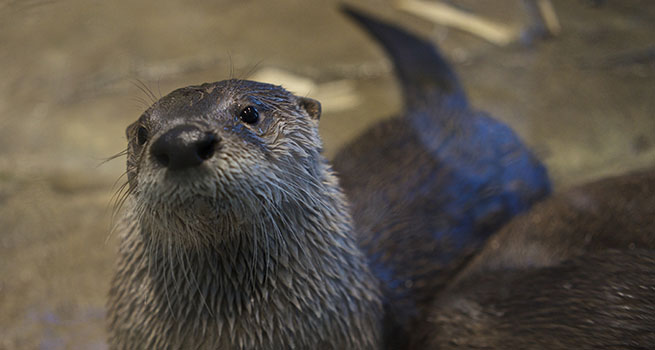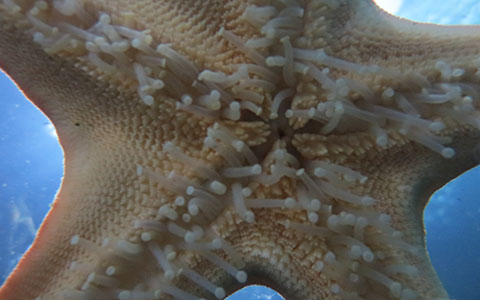How do sea stars eat? What is a river otter's favorite food? Do sharks hunt people? The answers may surprise you.

River otters live near the water’s edge, and can easily thrive in river, lake and estuary environments.
By Mallory Johnson
Published: March, 2016
How do sea stars eat? What is a river otter’s favorite food? Do sharks hunt people? The answers may surprise you. Read about three of the Bay’s top predators and find out what it takes to be an apex predator.
Sea Stars
Life in a tidepool isn’t easy, and only specialized animals and plants survive. Tidepool residents must withstand hammering waves when the tides roar in, and blazing sun, harsh winds and freshwater rain when the tides creep out. Not just any creature can spend a day in these conditions and live to tell the tale. Few animals are able to sustain such a lifestyle, but the ever-resilient sea star is not like most animals. Not only do sea stars thrive in tidepools, they rule them.
Sea stars are a keystone species within the tidepool ecosystems; their very presence contributes to the health of their habitat by helping to keep the rest of the food web in check. Sea stars are not picky eaters, and will dine on almost anything they can get their tube feet on, including clams, oysters, some snails or even other sea stars.
A sea star’s mouth is found on its bottom side, nestled amongst its tube feet. These marine invertebrates have some unique eating habits. In order to eat their food, sea stars will crawl over their meal and carefully throw up their stomachs, enveloping their meal while their digestive enzymes break it down. After a sea star is done eating, it will draw its stomach back in through its mouth.
River Otters
River otters are also top predators within their own ecosystems. River otters make themselves at home in burrows near the water’s edge, and can easily thrive in river, lake and estuary environments. River otters are keen and capable hunters and enjoy a variety of food sources. As semiaquatic carnivores, their prey largely consists of fish, but they’ll also snack on crustaceans, aquatic insects, frogs, rodents and even birds.
River otters are great at adapting to different environments, and are just as comfortable on land as they are in the water. They are excellent swimmers, reaching up to eight miles per hour in the water, yet they can run and play on land just as easily, using their clawed feet for traction. These lively creatures love to play in the snow and among icy and muddy hills, and they can often be seen sliding and chasing one another around.
River otters are a good indicator of the health of rivers. As the health of a stream, river or the Bay changes, so does the amount of their prey, and in turn, the number of otters. Without river otters to regulate prey populations, an overabundance of smaller animals can deplete the other animals and plants in the food web, disrupting the balance and resilience of the whole ecosystem.
Sharks
Sharks are quite possibly the most well-known and feared of all marine predators. While sharks are one of the top predators of the ocean, humans have very little to fear from these aquatic predators. A common misconception about sharks is that they’re thirsty for human blood. Not true! As a matter of fact, most sharks are picky eaters, and people are not on the menu. Most shark attacks on humans are simply a case of mistaken identity.
When looking up from under the surface of the water, sharks can only see the silhouettes of what’s above. Consequently, the shape of a surfer silhouetted against the water’s surface can be mistaken for a seal or sea lion, a favorite food of great white sharks, the species most commonly associated with this myth. However, once they realize that they did not bite into the mouthwatering blubber-filled pinniped they wanted, sharks will typically move on to find something more appetizing, which is why most shark attacks end in bites rather than actual fatalities.
Sharks have been around for over 400 million years, yet there’s still a lot about these prehistoric animals that remains a mystery. What we do know about them is that they play a vital role in the ocean’s ecosystem; however, many shark populations are threatened due to overfishing and overconsumption. As an apex predator, sharks help maintain a balanced lifecycle within the underwater community.
Take a bite out of science at Aquarium of the Bay as we celebrate the Bay’s top predators from March 19 to April 3. Find out what’s on the menu as we explore top predators like unassuming sea stars, keen river otters and awe-inspiring sharks. Have fun with hands-on science experiments and activities, all while learning about what it takes to be a top predator. Find out more at www.aquariumofthebay.org.
All photos in this story are courtesy of Aquarium of the Bay.
Mallory Johnson is the Communications Manager at Aquarium of the Bay, a nonprofit dedicated to protecting, restoring and inspiring the conservation of San Francisco Bay and its watershed.

A sea star’s mouth is found on its bottom side.

Sharks have been around for over 400 million years.

